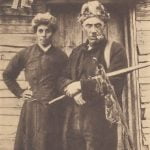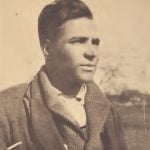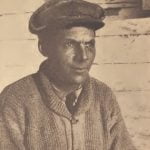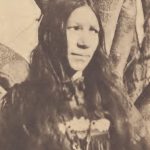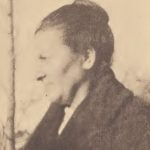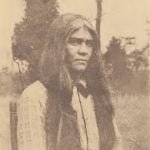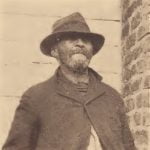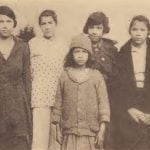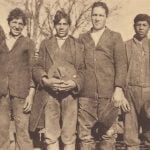For good reasons the Mattaponi 1 may be classified definitely as a branch of the Pamunkey. They have not only an absolutely identical cultural foundation, but are a member of the same original political body divided from the main body by a distance of ten miles, and occupying land which was evidently a portion of the original tract reserved under the name of Pamunkey reservation. Their present reservation of almost 75 acres is on the south bank of the Mattaponi River, near the hamlet of Wakema. Their own settlement is called Indian Town (fig. 25). It is a compact picturesque village of whitewashed houses on a high bluff above the river and commands a fine view.
There is a tradition at Pamunkey that the land intervening between the two reservations was sold for a barrel of rum. Mrs. Page, who in 1920 was 83 years of age, said that this was the understanding among the people of her generation. She was born at Mattaponi and asserts that Billy Major, her mother’s father, who died about 1845, could speak Indian. At Pamunkey there were at the time several in the families of Mush and Gunns who, it is claimed, knew the language.
The Mattaponi records in existence comprise a deed, according to Chief Custalow, referred to in a letter from L. C. Garnett, Assistant Attorney General, June 26, 1916. Through this instrument the Mattaponi lands were confirmed to the Indians in 1658, it is stated in the letter, by the Governor, Assembly of Virginia, Indian, Colonial and State Laws.
Thomas Jefferson made several remarks concerning the Pamunkey and the Mattaponi, one being that there were none of pure blood living in his time, 1781, and that the language had disappeared. His records, however, bear indication of being neither extremely accurate nor carefully considered, even from the historical point of view. It is doubtful whether he had an opportunity to do more than observe some of the natives at long range.
The Mattaponi have not been conspicuous in literature. Pollard 2 in 1894 quoted Dr. A. S. Gatschet as saying there were 35 or 40 Indians there. He also believed that they were a branch of the Pamunkey. In 1907 Mooney 3 took a census of the members of the band in his Powhatan survey, enumerating 40 souls and the following family names: Allmond, Collins, Custello (Costello), Langston, Major, Ried, and Tuppins. But now by birth and migration they have increased to about 75. Mooney’s remarks concerning their condition and their occupations hold true today as well as then. The community is less in touch with the outside world than the Pamunkey, and so exhibits a somewhat more rural aspect of culture than the other groups, excepting perhaps that at Adamstown. There is much intercourse between the Mattaponi and Pamunkey, several of the families having a common origin.
The question of priority is rather interesting here. The original families, that is to say those Mattaponi whose members have not resided off the reservation, have dwindled to two individuals according to the assertion of these two themselves, namely, Nanny Tuppins and Powhatan Major (figs. 17, b; 20, b). The assertion is validated by tradition, for it seems that the population consists for the rest of descendants of the adopted Pamunkey families and, what is more interesting, several Indians from the Powhatan groups lower down toward the bay. Among them, for instance, the ancestor of the Allmonds is known to have been a native of the band of Powhatan in Gloucester County. The grandfather of this family came from near Gloucester Point on York River, nearly opposite Yorktown. Descendants of this band are said to be still on the spot and to have a separate school. I have not, however, visited them to verify the statement.
Mattaponi Photo Gallery
Citations:


